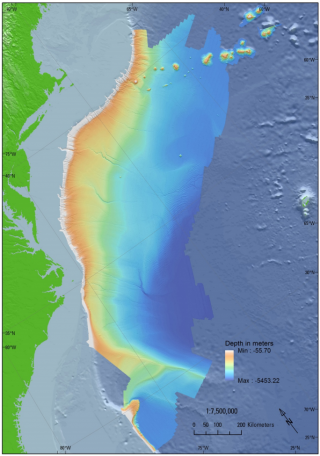The WaterWords: Continental Margin
Definition:
- If you have ever gotten grief from a teacher for doodling in the margins of your notebook, you are probably aware that a margin is an edge or a border. The continental margin, then, is the transition zone of the seafloor between the coast and the deep ocean.
Etymology:
- Continent comes from the Latin phrase terra continens, meaning “continuous land.” Margin also comes from Latin, in this case the word marginem, meaning “border,” or “edge.”

Use/Significance in the Earth Science Community:
- Continental margins are important areas of study for a variety of disciplines. In geology, some types of continental margins are be zones of high seismicity due to the proximity of tectonic plate boundaries. These are “active” margins, and the U.S. Pacific Northwest, southern Alaska, and California are examples of such active continental margins. Other continental margins are called “passive” because there is no nearby plate boundary. The U.S. Atlantic margin is a good example of a passive margin. Methane seeps – like those being studied on this research cruise – occur on both active and passive margins.
- There are a great many habitats in the continental margin, such as kelp and mangrove forests, coral reefs, and lagoons. These support a wide variety of plants, animals and other organisms.
U.S. Geological Survey/Schmidt Ocean Institute Use:
- USGS and SOI are currently collaborating on a research cruise off the coast of Oregon and Washington that will study methane dynamics and associated seafloor ecosystems on the continental margin. In particular, the scientists will focus on looking at gas hydrate formations, methane seeps, and the habitats that form near them.
- SOI has conducted many prior research cruises to study diverse types of continental margins, from the Pacific continental margin near Costa Rica to the Tasman Sea margin near Australia.
- The USGS Coastal/Marine Hazards and Resources Program (CMHRP) studies all of the US continental margins. Research on seafloor methane hydrates, gas seeps, and associated habitats has mostly focused on the U.S. Atlantic margin over the past few years through oceanographic cruises led by CMHRP and the USGS Ecosystems Mission area. The 2019 USGS research cruise with Schmidt Ocean Institute will expand studies of seafloor methane dynamics and seep ecology to the U.S. Pacific margin. U.S. Pacific margin research conducted by the USGS also includes studies of earthquake hazards and offshore geology, with a major new effort focused particularly on the Washington-Oregon margin.
Next WaterWord: Hydrothermal Vent

